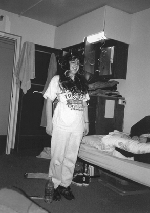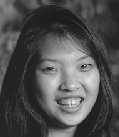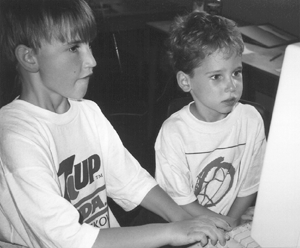Director's Digressions
A total of 76 students from thirteen states participated in the first four summer programs of DO-IT. The DO-IT Scholars program has been very successful. Of the 42 Scholars who have graduated from high school, most are now DO-IT Ambassadors. One of the roles of the Ambassadors is to share their college and employment experiences with the younger Scholars. Most of this is done via electronic mail since our Scholars and Ambassadors live all over the United States. As indicated in the summary below, they have many experiences to share with others.
- Thirty-two (32) are currently enrolled in higher education institutions.
- One is in a trade school.
- One is applying to colleges.
- One took a post-secondary computer programming course and is now employed.
- One is self-employed as a computer consultant.
- One took two years of engineering training and is now employed and has plans to return to college.
- One completed one year of college and is now on a two-year mission with the church, after which he plans to return to college.
- One is receiving training at a state school for the blind.
- One graduated with an associate degree and is seeking employment.
To give you a sense of the types of personal experiences and tips DO-IT Ambassadors share with others, here are some excerpts from electronic mail correspondence this past fall. Some entries have been modified to conserve space. Some of the questions they discussed are:
What classes are you taking?
Where are you living?
What is your best moment so far? Your worst?
What suggestions would you give to high school seniors who are preparing to start college next year?
- Ambassador who uses a wheelchair - I love the atmosphere here. At lunch you see people playing drums in the courtyard and people talking their mind on an open microphone. I'm living at home and commuting. It's about an hour drive each way. My advice to up-coming college students is to keep on top of where your money is coming from (government agencies can ruin your day) and to thoroughly check out the campus. Find accessible routes to buildings, etc. I also suggest writing a letter about yourself to your profs, not relying on counselors to do it. I did and my profs appreciated it.
- Ambassador with cerebral palsy - When you start college, take it slow by taking one or two classes at first to see how it goes then work your way up. College is supposed to be fun!
- Ambassador with cerebral palsy - College is very different than secondary education. I only have two classes. They're Writing 10 and Study Skills 31. I'm living at home. Now I'm wondering if college will be easier when I move out because there will be fewer distractions. My family and I didn't realize how much more work I'd have and how much money it will cost without any scholarships.
- Ambassador with learning disability - I have just finished my first term. The classes that I am going to be taking next term are Philosophy 100, English 101, and Math 101. This is 15 credits. I am living at home and driving to school everyday. I do not know what the best moment has been for me. The worst moment is when another student cut his arm in the middle of giving a speech.
- Ambassador who has a head injury - I don't think you need any luck to excel in your studies; you're part of DO-IT, the most supportive program in the nation.
- Ambassador with visual impairment - I live in one of the residence halls here on campus. Probably one of my worst moments is when I got really sick during finals week. One of my best moments was when I pulled almost an A+ in both of my computer science and math courses. Also meeting some wonderful people. To seniors in high school, try a roommate for the first term or semester in college. You might like it. It is nice to have somebody to talk to, but you may not get along with them either.
 Ambassador Anna's crowning glory (wrapped around with slinky) for acandemic excellence.
Ambassador Anna's crowning glory (wrapped around with slinky) for acandemic excellence. - Ambassador with cerebral palsy - I'm living at home. I have learned a lot about what things a person can accomplish if they stick their mind to it. I'm telling you this because I hope that some of you still in high school will realize you can do things no matter what your limitations are. Just remember you're in DO-IT, so you have to be very smart in order for Sheryl to accept you in her program, so I bet that you're also smart enough for just about anything in this world.
- Ambassador who is blind - College is not an easy business. Here are some lessons I learned:
- You should save your completed assignments on disk in case of emergency. For example, if your work did not print out very well or your instructor loses it then you can just go print it out at the technology center instead of having to start over.
- You should always pick up your letters of introduction on the day of registration to reduce the confusion over your accommodations. I had a hard time getting my English instructor to accommodate simply because I had forgotten to pick up those letters of introduction.
- Ambassador with mobility impairment - I'm just taking one class through the local high school, Writing 121, and getting credit from a local community college.
- Ambassador with a visual impairment - I work part-time here as one of the university's network administrators. I am visually impaired, but I really don't let that bother me. This year, in addition to school and computer work, I'm teaching the Honors General Chemistry Lab.
- Ambassador who is blind - My quarter's sucked in a major big way, and I'm not quite sure what I could have done about it. The first six or seven weeks, I couldn't do anything besides study because I had so much to do. I know, this is hard to believe. I wouldn't have believed it possible, but now I've been there and it can happen. Result, the past few weeks I've slacked major big time which isn't good either. Basically, I expended all my motivation and energy on the first two thirds of the quarter. I had to, but it's having bad repercussions now. I know that's not how you spell that word. Hmmmmmmmmm. Thankfully, next quarters labs sound more fun, less intense, and more tactile.
- Ambassador who is blind - I have been having considerable difficulty with my disability accommodations at the college. One of the main problems is the Braille material for my math class. The way it was written, there are some characters I am not understanding. My one-on-one advisor and I discovered that I was getting some of the problems wrong because there were some Braille symbols that were either left out or misplaced.
- Ambassador who is blind - With Braille new symbols appear as you get into more advanced math and you have to learn them. Sometimes, in order to learn them you need a sighted person to explain them to you, then you know them next time. This is necessary sometimes because so much Braille stuff overlaps and depends on context.
My second calculus book was badly brailled. The braillist wasn't actually up to it. The mistakes they made were bizarre, often had to do with not properly edited scanning, everything was late, and they refused to do graphs. We ended up switching mid quarter. The problem in my instance was that Disabled Student Services got good references about the braillist, the braillist aid they could, and then they couldn't. I have a couple really good ones now.
- Ambassador with learning disability - I have received some accommodation but mostly just extended time on tests. The center here has been really helpful, I could have got notetakers, books on tape, you name it. Plus they have a seminar of the teachers to that they know haw to deal with LD students. Many teachers are very helpful and will read and critique papers for me.
- Ambassador who is blind - Living at home still provides plenty of distractions, believe me. I have my own dorm room this year. I like that. Mine mine mine mine mine!!!!!! I throw all my Braille books on the other bed. Heehee!
- Ambassador with mobility impairment - At least I don't have to eat DORM FOOD!!!!
- Ambassador with mobility impairment - College is supposed to be fun? Yeah right! :-)
DO-IT Scholars and Ambassadors also received support and guidance from DO-IT Mentors. Here is one piece of advice from a Mentor with cerebral palsy, "My advice for community college students is get your spelling, vocabulary, and English down pat. You'll get a long ways with those skills down. Math too. College uses lots of brain work."



